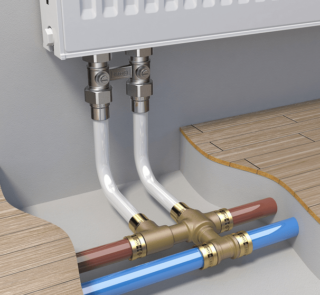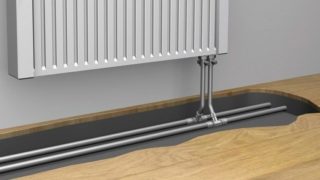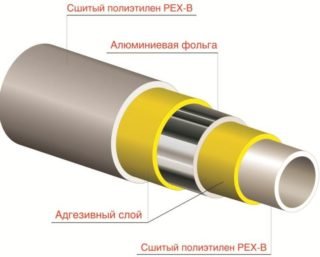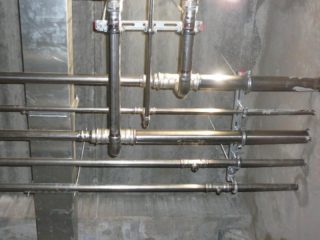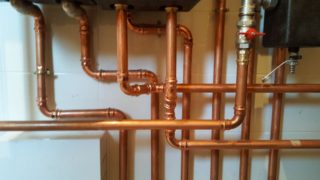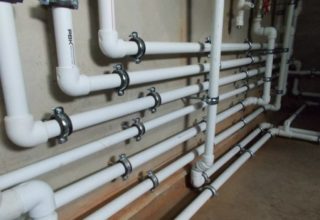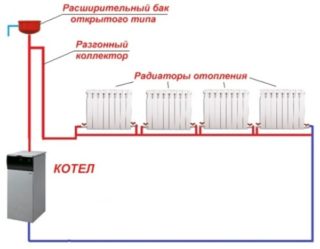When creating or reconstructing a home pipeline, it is worth considering the quality of heating, the efficiency of the coolant flow and the cost of utility bills during the heating season. To choose pipes for heating, it is necessary to take into account the boiler power, the total load on the communications, material and technical parameters of the products.
The main criteria for selecting pipes for heating
It is impossible to choose universal tubular products. If the system is only being designed or it is planned to replace the obsolete trunk, you should pay attention to such factors:
- pipe section parameters;
- boiler power indicator and fuel type;
- general quadrature of heated rooms;
- type of gasket - is equipped with an open and closed method;
- features of creating a contour - you can perform an external or open location, install in the floor or walls, lead to a radiator;
- the presence of a pump for forced movement of the coolant;
- temperature indicators of a separate section of the circuit;
- pressure in the system - in the centralized system of a multi-storey building reaches 16 atm., in an individual private - up to 2-3 atm.
Consider the presence of unheated rooms and maintainability of the highway.
Characteristics of materials
In a private house or country cottage, a pipeline of metal (black, copper, stainless steel) or plastic (polypropylene, polyethylene with crosslinking, metal-plastic) is advisable. To compare the operational characteristics of pipes designed for heating communications, it is worth referring to the table:
| Material | Work temperature, ° С | Roughness mm | The probability of pressure loss, hPa / m | The coefficient of linear expansion, mm / m * deg. |
| steel | 130 | 0,07 | 5 | 0,012 |
| metal plastic | 95 | 0,004 | 1,5 | 0,025-0,03 |
| polyethylene | 90 | 0,007 | 1,8 | 0,15-0,17 |
| polypropylene | 70 | 0,01 | 2 | 0,15-0,17 |
Metal products can withstand high loads, but inside the house it is better to use options that can withstand the temperature of hot water.
Varieties of materials for heating pipes
The performance of the system, the method of its installation and the ability to independently calculate heat losses depend on the type of material. Manufacturers produce metal and polymer pipes.
Features of the metal pipeline
For the manufacture of pipes, black, stainless or galvanized steel is used. This metal is durable and resistant to mechanical stress. The working temperature of the route is 130 degrees, and the maximum pressure indicator is 30 atm. Steel does not ignite if there is a hot coolant inside.
The disadvantages of the black and galvanized pipeline are the heavy weight, the difficulty of self-assembly, large heat loss and roughness of the inner layer, where deposits can accumulate. All types of metal, with the exception of stainless steel, must be painted.
The metal type of pipes without an anti-corrosion layer has been in operation for 15 years, with a special coating - up to 50 years.
The specifics of products from composite polymers
Polymers are polyethylene, polypropylene and metal-plastic. These pipes are best used for heating a private house due to long-term operation - about 30 years. A coolant with a temperature of 95 degrees can circulate through the system.
Composite polymers are distinguished by their ductility, which excludes track cutting, the number of fittings.Plastic is not subject to corrosion, so you can make a hidden installation in the wall or arrange a warm floor. Select the wall thickness (from 1.8 to 3 mm) according to the pressure level of the circuit.
The disadvantage of composites is deformation during overheating, rupture during freezing of the coolant. Due to the smoothness of the inner walls, no plaque forms on the pipes.
The contour of modifications with an anti-diffuse layer is not airy.
Plastic pipes
Products are distinguished by attractive appearance and a variety of diameters - from 16 to 63 mm. The walls of the reinforcement are 2-3 mm thick, the permissible long-term temperature of the coolant is 95 degrees, short-term - 110 degrees.
The design is multi-layered, which allows the line to withstand heavy loads. A standard metal-plastic pipe consists of the following elements:
- the outer layer is cross-linked polyethylene, resistant to temperature, shock and chemical influences;
- sizing - needed for bonding materials;
- reinforcement - flexible and durable aluminum is used;
- inner layer - smooth cross-linked polyethylene.
The reinforced layer can reach 190-300 microns in thickness, which allows it to withstand pressure up to 8 kPa.
The track is connected by crimping with fittings or collets using a special key. The docking method is selected by the owner or installation specialist on site. The material is flexible, which ensures ease of self-installation with a pipe bender.
The bend of the plastic pipe is formed manually, with an optimal radius of 80-125 mm.
Pros and cons of steel and copper pipes
Features of Steel Pipeline
Until the end of the twentieth century, a steel pipe was the only way to equip heating. Currently, owners of private homes prefer to make carbon steel communications.
The material has several advantages:
- resistance to water shocks, temperature and pressure fluctuations;
- excellent strength and resistance to mechanical stress;
- minimum expansion coefficient, excluding compensators;
- good thermal conductivity;
- inexpensive price of the material even when buying consumables.
The steel type of communications has several disadvantages:
- minimum resistance to corrosion;
- the roughness of the walls, as a result of which deposits are formed;
- corrosion risks due to leakage;
- heavy weight;
- the need for welding skills and special equipment for installation;
- painstaking threading with a threaded connection;
- transmission of stray currents by iron.
Galvanized models practically do not corrode.
Features of the copper pipeline
A copper battery and similar fittings are still used in private homes. The reasons for their use are:
- durability - metal material is not destroyed for 100 years;
- high tightness, corrosion resistance;
- lack of deposits inside;
- high thermal conductivity;
- operating temperature range from -200 to +500 degrees;
- resistance to pressure drops.
The disadvantage of a copper pipeline is the high cost of the material itself.
Copper pipes cannot be combined with unalloyed steel products - they will quickly rust.
Polymer and metal-plastic reinforcement type
Characteristics of polymer reinforcement
Modern PP pipes are made of non-toxic synthetic polymer. They differ in impact resistance, the possibility of repeated bending, wear resistance and dielectric properties. PVC pipes used for heating can withstand pressure up to 25 bar at a temperature of 0 to +25 degrees and 10 bar for short-term heating (from 70 degrees and above).
The polymer type of reinforcement has several advantages:
- universality - an apartment, production facilities or a private house is equipped with such a highway;
- ease of DIY installation in the presence of a boiler with a maximum heating of the coolant up to 70 degrees;
- minimum costs for components;
- smoothness of the inner surface where deposits do not accumulate;
- Using simple installation tools
- long period of operation - almost 25 years;
- beautiful appearance of the track;
- resistance to low temperature.
The plastic type of pipe is characterized by low rigidity, as a result of which the lines can sag, crack and break.
The efficiency index of a home system depends on the reinforcement of the PP pipe. Manufacturers use several types of reinforcing material:
- Foiling - sealing is done outside, in the middle and inside with the help of non-continuous, corrugated and continuous sheets. The foil excludes expansion when heated.
- Fiberglass layer - is placed in the middle of the pipe by coextrusion. Fiberglass when welding fittings creates a strong connection that does not delaminate.
- Composite mixtures - formulations are used in which polypropylene is mixed with fiberglass. Pipes receive additional strength and resistance to mechanical stress.
Fiberglass reinforcement is the best option for home construction.
XLPE pipe
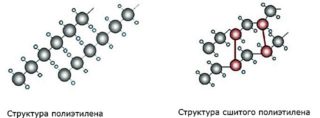 The polypropylene type of reinforcement is ethylene with chemical or physical crosslinking of molecules. Finished products get a homogeneous structure, flexibility and high tensile strength. The main advantages of designs:
The polypropylene type of reinforcement is ethylene with chemical or physical crosslinking of molecules. Finished products get a homogeneous structure, flexibility and high tensile strength. The main advantages of designs:
- good shrinkage rates;
- shape retention according to the level of the compound even when the temperature rises to 200 degrees;
- wear resistance and integrity in high pressure conditions;
- low coefficient of expansion during thermal exposure;
- the possibility of laying in a hidden way;
- the ability of fragments to remember the position in the system.
The polyethylene type of the pipeline is destroyed by ultraviolet radiation.
Features of metal-plastic reinforcement
For production, plastic and an aluminum foil frame with an adhesive bond are used. The fittings are suitable for rooms in which there is constant heating. It is connected using fittings - detachable and one-piece. The hitch must only be carried out by a specialist.
The metal-polymer type of the system has the following properties:
- corrosion resistance - only the plastic layer comes into contact with the coolant;
- smoothness of the inner surface, where plaque does not accumulate;
- tightness that retain foil;
- good flexibility indicators - convenient for rooms of any configuration;
- sale in bays of 50-500 m, which eliminates overpayments per meter of material, reduces the number of rations;
- operation duration - up to 50 years;
- low coefficient of linear expansion - the pipeline can be mounted on the wall.
The material is not resistant to UV rays, so it fits into a corrugated pipe.
Which pipes to choose
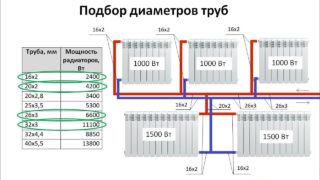 Choosing pipes for heating, it is worth considering which products will be better in efficiency for a private house, pay attention to operating conditions and the complexity of installation.
Choosing pipes for heating, it is worth considering which products will be better in efficiency for a private house, pay attention to operating conditions and the complexity of installation.
Polypropylene is characterized by high tightness, ease of independent connection and low weight. Pressure is not created on the load-bearing systems, and the smoothness of the walls prevents the formation of deposits. The rigidity of the material involves the use of fittings to create a turn. If one area fails, it is necessary to completely change the system.
Metal-plastic - reliable, notable for the simplicity of independent organization of the highway. You can connect the products with a wrench, but the solder points may be damaged. Metal-plastic fittings are justified if you need to heat the house in a constant mode.
In the presence of financial means it is worth stopping the choice on a stainless highway with a service life of up to 100 years.
Sizing Rules
The pipe sizes depend on the square of the heated area:
- optimal diameter for crowded places - 200 mm;
- in small houses, products of 20-30 mm in diameter are suitable;
- in the presence of hot water supply, a 25 mm pipe is put into risers, the remaining sections are made of 20 mm pipes;
- central heating is performed from fittings 25 mm in diameter;
- for underfloor heating, constructions with a diameter of 16 mm or more are suitable.
For an accurate calculation of the parameters, you should contact professionals or use an online calculator.
The specifics of installing heating pipes in a private house
In a private house, a single-pipe or two-pipe heating system can be used.
Single tube execution
The principle of arranging communications is to connect all radiators to one collector. The device will work for supply and return, and the coolant will move along the batteries in the form of a closed ring.
When organizing a one-pipe scheme, radiators cool down faster, so you will need to add sections. The diameter of the manifold must be larger than the size of the pipe.
The scheme is implemented in several ways:
- Leningradka, or horizontal - up to 5 radiators are used. A larger number of elements will not allow the latter to warm normally. Communications are suitable for a small or country house.
- Vertical - you will need one-pipe vertical risers. The design is justified in a two-story house.
The batteries of a single-tube system act on each other, so it is problematic to connect automation.
The implementation of the two-pipe scheme
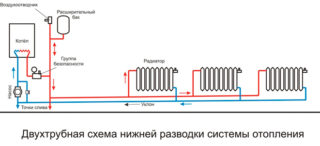 The main characteristic of communications is the supply of coolant to the radiators through one pipe and the return through the other. The fuel temperature does not change with this wiring, so sections are not added.
The main characteristic of communications is the supply of coolant to the radiators through one pipe and the return through the other. The fuel temperature does not change with this wiring, so sections are not added.
There are several ways to connect a trunk:
- Dead end - the entire network is divided into several shoulders (branches). The thermal carrier moves towards the pipes.
- Associated - the reverse collector continues to feed. The coolant has one direction, which closes in the form of a ring.
- Collector, or beam - wiring provides for the supply of a separate pipe from the collector to the radiator. The highway is hiding under the floor.
When laying large pipes with a slope of 3-5 mm / 1 m, gravity-free operation of the system is possible.
The selection of heating pipes should be carried out depending on the materials, the possibility of permanent residence in the house. Manufacturers produce several types of products that differ in cost and installation complexity.
